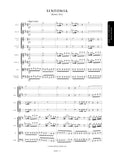Details
|
For a part-time composer Ordonez was a surprisingly prolific. In addition to his two operatic works - a marionette opera, Musica della Parodie d'Alceste and a Singspiel, Diesmal hat der Mann den Willen - Ordonez is known to have composed a significant amount of church music (now lost), a secular cantata, 73 symphonies, a violin concerto and a large corpus of chamber music of which the 27 authenticated string quartets are of particular importance. Ordonez's sophisticated experiments with cyclic unity and his liking for contrapuntal textures gives much of his music a very distinctive and original quality. His symphonies were widely disseminated in manuscript copies and Abb Stadler noted that they "received great applause".
While much has been made of the growing length and complexity of symphonies from the 1760s on, many composers working in Vienna, Ordonez among them, still favoured writing short, bright, attractive works with little concern for emotional or intellectual depth. To dismiss these work as irrelevant in the broader historical scheme of things is both arrogant and foolish. It leads to a general misunderstanding of the role of the symphony in the musical life of the period and fails to recognize the immense diversity within the genre. The present work is a fine example of the Viennese symphony in miniature from its strong, confident opening movement to its tiny, exuberant Finale.
This edition is based on a set of contemporary manuscript parts in the possession of the Frst Thurn und Taxis'sche Hofbibliothek in Regensburg. The wrapper reads "Sinfonia [in D No.1] / a /2 Violini / 2 Corni / Viola / e Basso / del Sigre Ordonitz". In the absence of the autograph score or a set of authentic performing parts, the edition seeks to present as faithfully as possible the intentions of the composer as transmitted in the Regensburg source. The parts are unusually devoid of articulation markings; the style of the few that occur, and of the dynamic markings, has been standardised throughout, and, where missing, reconstructed from parallel passages. These are indicated by the use of dotted slurs or brackets where appropriate. Like most eighteenth century sources, the Regensburg manuscript is inconsistent in its notation of appoggiature; these too have been standardised to minimise confusion. Obvious wrong notes have been corrected without comment; editorial emendations with no authority from the source are placed within brackets.
Allan Badley
|














